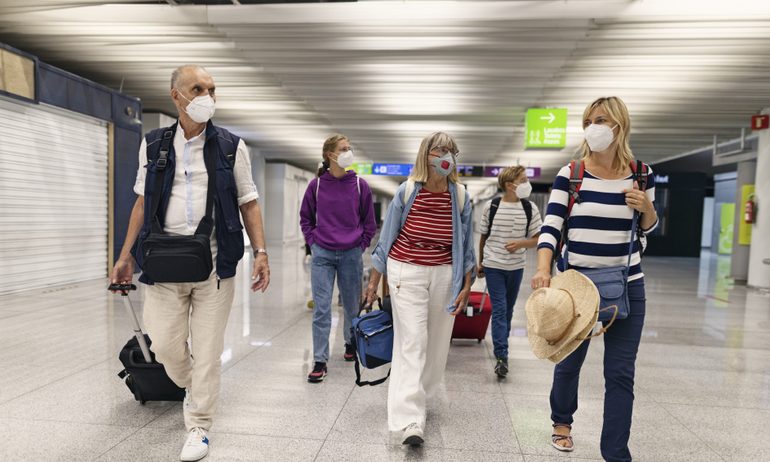The Surprising Change in Airfares Since Last Year
Airfares dropped 4.6% in terms of unadjusted percent change between October 2020 and 2021.

Many or all of the products on this page are from partners who compensate us when you click to or take an action on their website, but this does not influence our evaluations or ratings. Our opinions are our own.
Travel is returning, but here's good news for those who are flying: higher fares may not.
Despite the fact that prices for pretty much everything have gone up in 2021, airfare prices dropped 4.6% over the past year in terms of unadjusted percent change between October 2020 and 2021. That's according to Consumer Price Index data released by the U.S. Bureau of Labor Statistics in November, which showed that overall inflation reached a 30-year high in October.
The CPI, which tracks prices of everything from food to fuel, surged 6.2% for the 12 months ending in October, marking the largest 12-month increase since December 1990. Only a handful of areas actually saw a price decrease over the past year — and one of them is the cost of airline tickets. The price drop follows an even more dramatic drop from October 2019 to 2020, when airfares saw prices plummet 20% by that same metric.
That news might come as somewhat surprising, especially given that 43% of Americans say they intend to spend money on flights or hotel stays for this year's holidays, according to a September NerdWallet survey conducted by The Harris Poll of more than 2,000 U.S. adults. That’s up dramatically from the 19% of Americans who said they spent money on flights or hotel stays during 2020’s holiday travel season.
Throw in the fact that earlier this month, the Centers for Disease Control and Prevention endorsed authorization of Pfizer-BioNTech’s coronavirus vaccine for children 5 to 11 years old, and it seems as though travel demand might be higher than it’s ever been since the beginning of the pandemic.
So why aren’t airfare prices rising with demand? Adit Damodaran, an economist for online airfare booking site Hopper, says it’s not that simple.
The deals are abroad
The CPI doesn’t distinguish between airfares for domestic versus international itineraries. Discounts are still hard to come by for families trying to score holiday travel deals to visit relatives within the U.S. this year.
Hopper’s own flight price index found that domestic flight prices are actually 6% higher than they were last year. As it stands, the real deals can be found for flights bound to destinations outside of the U.S.
“International flights in October were 2% below even 2020 prices, led by low airfares to Europe,” Damodaran says.
Late this August, the European Union recommended that its member states reinstate restrictions on U.S. tourists due to rising case rates in the country, plummeting European travel demand. General hesitation to travel — both at home and abroad — was likely further driven by delta variant-related concerns (delta cases in the U.S. peaked in late September, according to CDC data). Hopper data released in September found that round-trip airfare to Europe dropped to $565 on average, its lowest level in five years.
But then, a nearly 20-month international travel ban for travelers visiting the U.S. was lifted this month (international visitors must now show proof of full vaccination and a recent negative COVID-19 test). With that, airlines are adding international routes and creating additional supply. For example, JetBlue launched nonstop service between New York’s John F. Kennedy International Airport and London's Gatwick Airport in September. Then, Aer Lingus announced in October that it would begin operating its first ever nonstop direct flights between Manchester and New York in December.
October was a bizarre month that got caught between an increase in supply and a decrease in demand, likely leading to overall airfare discounts.
Passengers may be buying basic economy tickets
The CPI also doesn’t distinguish between basic economy versus standard or premium cabin airfares. Basic economy airfares typically have a lower base fare than the rest, but these a la carte-style airfares will separately charge you for add-ons like checked baggage, freedom to change or cancel your flight, or the ability to select your seat.
In the early days of the pandemic, travelers might have splurged for premium cabin seats to get a little closer to the 6 feet apart that the CDC recommends you stay from others. Or, perhaps, basic economy fares and their notorious inflexibility were largely unappealing amid the uncertainty of COVID-19 travel regulations.
Meanwhile, business travelers, who typically account for higher spending than leisure travelers, still haven’t returned. The Global Business Travel Association doesn’t anticipate a full recovery until 2025.
Basic economy fares might be more appealing these days for no-frills, casual vacationers. And while the airfare itself is certainly cheaper than a standard fare, you might end up paying the same once you account for all of the extra fees.
How long will cheap airfares last?
Not long. In fact, Hopper’s Damodaran says you may have already missed the window for cheap airfares.
“Currently, our domestic 2021 airfare is tracking at 19% above 2020 prices, with international airfare up 4% as well,” he says. “Domestic airfare is nearing 2019 prices for the holidays.”
He added that domestic flight searches on Hopper are up 25% since the beginning of October, while international flight searches are up 70%.
A big driver is simply travel demand, as people feel more comfortable traveling and are eager to make up for last year’s missed travels. Plus, with higher jet fuel prices, you should expect those increased costs to be passed on to the consumer via higher airfares.
How you can still find airfare deals
October airfares dropped, but they’re creeping back up. Thankfully, it’s not too late to find airfare deals.
Consider booking with frequent flyer miles
If you’ve been spending on a travel rewards credit card but haven’t actually traveled, you might have a healthy trove of points and miles to spend. While points and miles from big credit card issuers like American Express or Chase can be used to book airfare directly through the company’s online travel portals, they’re usually more valuable when transferred to a frequent flyer program of an airline or a hotel loyalty program.
Be flexible
It’s not uncommon to find a three-figure difference in airfare just by increasing or shortening the length of your trip by a day. Even if you find yourself paying for an extra hotel night, it might be worth extending your trip if airfare is significantly cheaper to fly out one day later.
And don’t overlook nearby airports. Most major cities are served by multiple airports, so broaden your search. The taxi might be a couple bucks more to drive to the farther airport, but it could be worth it for the savings.
Use tools to search for flights
Many free online tools make searching for deals easier. Flight search tools like Google Flights, Kayak or Skyscanner can compare prices by day and nearby airports. They also typically allow you to set alerts for airfare deals, which can be useful if you know you want to fly to a certain airport but are flexible as to when you depart.
Chase Sapphire Preferred® Card
Travel
Dining
🔥 Huge highest-ever bonus on NerdWallet's 2025 Best All-Purpose Travel Rewards Card is back. Don't miss your rare chance to: Earn 100,000 points when you spend $5,000 on purchases in the first three months. That's worth at least $1,250 toward travel booked through Chase.


